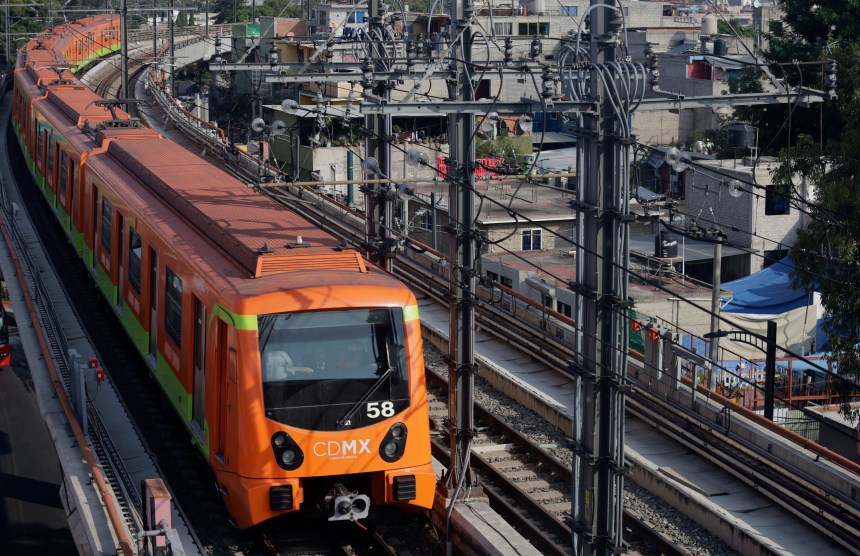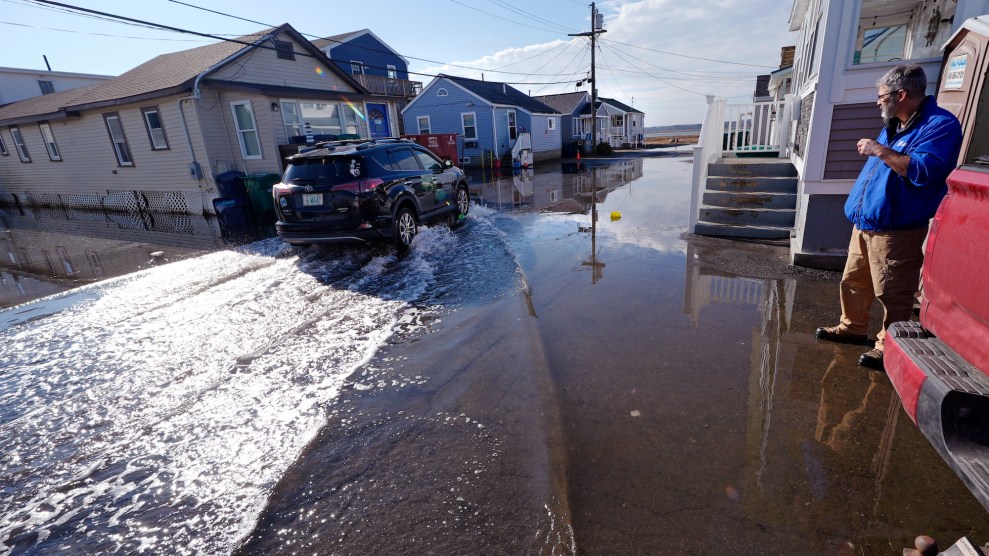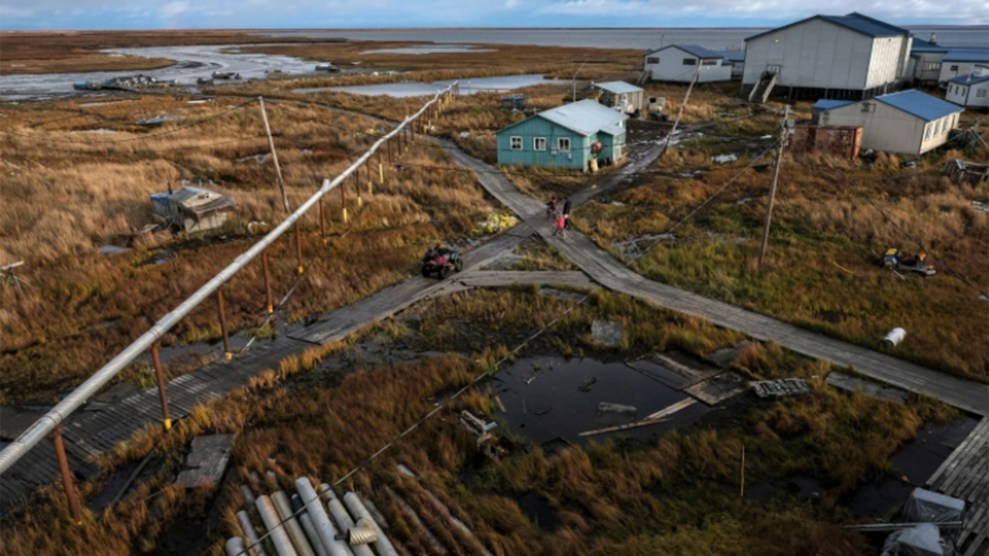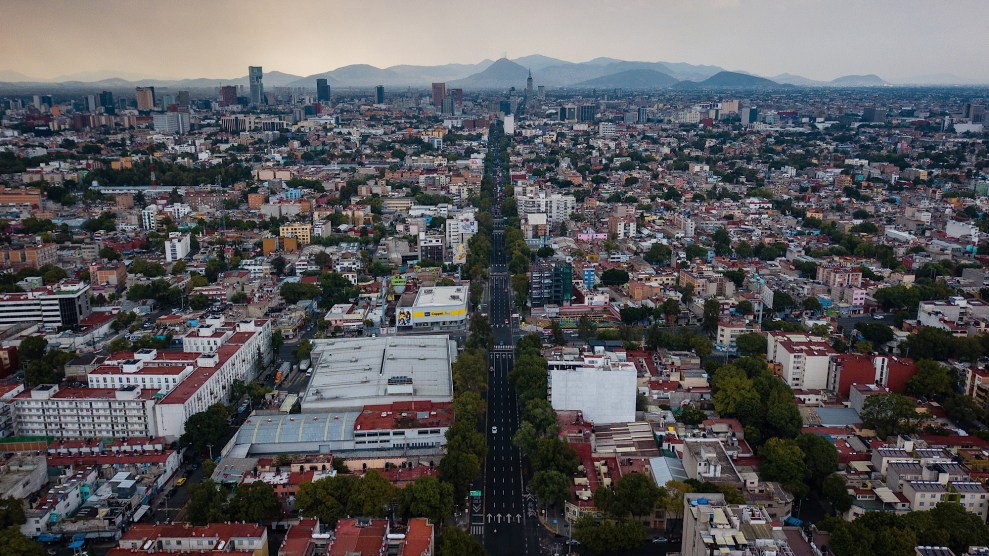
San Andres Tomatlan metro station on Line 12 of the Mexico City Metro Collective Transportation System, July 2023.Gerardo Vieyra / ZUMA
This story was originally published by Wired and is reproduced here as part of the Climate Desk collaboration.
With its expanse of buildings and concrete, Mexico City may not look squishy—but it is. Ever since the Spanish conquistadors drained Lake Texcoco to make way for more urbanization, the land has been gradually compacting under the weight. It’s a phenomenon known as subsidence, and the result is grim: Mexico City is sinking up to 20 inches a year, unleashing havoc on its infrastructure.
That includes the city’s Metro system, the second-largest in North America after New York City’s. Now, satellites have allowed scientists to meticulously measure the rate of sinking across Mexico City, mapping where subsidence has the potential to damage railways. “When you’re here in the city, you get used to buildings being tilted a little,” says Darío Solano‐Rojas, a remote-sensing scientist at the National Autonomous University of Mexico. “You can feel how the rails are wobbly. Riding the Metro in Mexico City feels weird. You don’t know if it’s dangerous or not—you feel like it’s dangerous, but you don’t have that certainty.”
In a recent study in the journal Scientific Reports, Solano‐Rojas went in search of certainty. Using radar satellite data, he and his team measured how the elevation changed across the city between 2011 and 2020. Subsidence isn’t uniform; the rate depends on several factors. The most dramatic instances globally are due to the overextraction of groundwater: Pump enough liquid out and the ground collapses like an empty water bottle. That’s why Jakarta, Indonesia, is sinking up to 10 inches a year. Over in California’s San Joaquin Valley, the land has sunk as much as 28 feet in the past century, due to farmers pumping out too much groundwater.
A similar draining of aquifers is happening in Mexico City, which is gripped by a worsening water crisis. “The subsurface is like a sponge: We get the water out, and then it deforms, because it’s losing volume,” says Solano‐Rojas. How much volume depends on the underlying sediment in a given part of the city—the ancient lake didn’t neatly layer equal proportions of clay and sand in every area. “That produces a lot of different behaviors on the surface,” Solano‐Rojas adds.
Subsidence rates across Mexico City vary substantially, from 20 inches annually to not at all, where the city is built atop solid volcanic rock. This creates “differential subsidence,” where the land sinks differently not just square mile to square mile, or block to block, but square foot to square foot. If a road, railway, or building is sinking differently at one end than the other, it’ll destabilize.
That’s how you get the tilted road traffic barriers at Acatitla Station and the deformation of tracks at Oceanía Station. If in either of these places the land was subsiding at a uniform rate, the tracks and road would also sink uniformly, and you might not have a problem. “We found that some of the segments of the Metro system are moving faster” than it was designed for, says Solano‐Rojas.
The study found that nearly half of elevated segments of the Metro are experiencing differential subsidence. This would imply that they would need to be serviced before the system’s typical threshold of 50 years, at which point a segment would need rehabilitation or repair to continue optimal operation. Sistema de Transporte Colectivo, which operates the Mexico City Metro, did not provide comment for this story after repeated inquiries.
A metro system by its nature is a sprawling web of lines: Mexico City’s includes 140 miles of tracks running underground in subways, aboveground as you can see above, and on elevated platforms. “It goes from areas that are really stable, to areas that are subsiding at 30 centimeters per year, or even almost 40 centimeters every year,” Solano‐Rojas. “So the goal here was to see where the most damage could be.”
That damage comes in a few forms. As the land sinks, it can create divots for rainwater to accumulate, causing flooding along railways. That can mess with the electrical system that powers the trains, Solano‐Rojas says.
And elevation changes can increase the grade of the rails. The Metro’s trains are designed to operate on a maximum slope of 3.5 percent, Solano‐Rojas says, but some stretches of track are now double that due to subsidence. “Trains can get derailed very easily if there is a slight change in the leveling of the railways,” says Manoochehr Shirzaei, an environmental security expert at Virginia Tech who studies subsidence but wasn’t involved in the new paper. “Most of the infrastructure has certain thresholds; it tolerates a certain level of differential land subsidence. But often they don’t account for the rate that we see, for example, in Mexico City.”
Solano‐Rojas and his colleagues found subsidence in the area of an overpass near the Olivos station, which collapsed in 2021 while a Metro train was traveling over it. “We did part of this analysis before 2021, and we detected that that area was having differential displacements,” says Solano‐Rojas. “We were like, ‘Oh, yeah, it looks like something could be happening here in the future.’ We think that it’s not a coincidence that we found this.” Solano‐Rojas was careful to say that the potential contribution of subsidence to the disaster would require further evaluation, and official investigations have cited construction errors and do not mention subsidence.
For this study, the researchers looked at the Metro infrastructure aboveground, not the subway segments—basically, the parts of the system they could verify visually. But by providing the system’s operators with information on how quickly its infrastructure might be subsiding, their work can hopefully inform interventions. Engineers can add material underneath railways, for instance, to restore lost elevation. Bolstering subways, though, could be much more challenging. “We don’t have a concrete solution for that,” says Shirzaei. “In most cases, when that happens, it just results in shutting down the project and trying to open a new lane.”
This isn’t just Mexico City’s problem. Earlier this year, Shirzaei and his colleagues found that the East Coast’s infrastructure is in serious trouble due to slower—yet steady—subsidence. They calculated that 29,000 square miles of the Atlantic Coast are exposed to sinking of up to 0.08 inches a year, affecting up to 14 million people and 6 million properties. Some 1,400 square miles are sinking up to 0.20 inches a year.
Differential subsidence is not only threatening railways, the researchers found, but all kinds of other critical infrastructure, like levees and airports. A metropolis like New York City has the added problem of sheer weight pushing down on the ground, which alone leads to subsidence. The Bay Area, too, is sinking. On either coast, subsidence is greatly exacerbating the problem of sea level rise: The land is going down just as the water is coming up.
Wherever in the world it’s happening, people have to stop overextracting groundwater to slow subsidence. Newfangled systems are already relieving pressure on aquifers. It’s getting cheaper and cheaper to recycle toilet water into drinking water, for instance. And more cities are deploying “sponge” infrastructure—lots of green spaces that allow rainwater to soak into the underlying aquifer, essentially reinflating the land to fend off subsidence. Such efforts are increasingly urgent as climate change exacerbates droughts in many parts of the world, including Mexico City, putting ever more pressure on groundwater supplies.
With increasing satellite data, cities can get a better handle on the subsidence they can’t immediately avoid. “I really feel like governments have a chance to use these kinds of studies to have a more structured plan of action,” says Solano‐Rojas.















